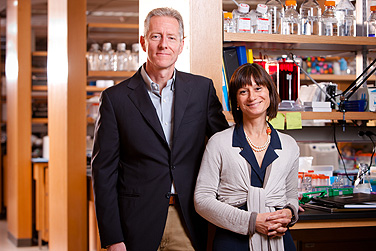Close Up
Arrival of Wrabetz and Feltri moves
work of Kelly institute forward

Lawrence Wrabetz and Laura Feltri arrived at UB last spring with 10 research associates and 56 lines of transgenic mice. Photo: DOUGLAS LEVERE
-
 Print
Print -
 Comments
Comments
-
“A multidisciplinary foundation will be a better way to increase the probability in coming up with applications of therapeutic strategy. The key point in all of this is to work in parallel.”
The mission of the Hunter James Kelly Research Institute (HJKRI) is moving forward with great fervor with the recent arrival of highly regarded neuroscientists Lawrence Wrabetz and Laura Feltri.
Dubbed “physician-scientist superstars” by Michael Cain, dean of the School of Medicine and Biomedical Sciences, at the press conference in 2010 announcing the pair’s recruitment to UB, Wrabetz is the institute’s first director and holds a primary appointment in the Department of Neurology, with a secondary appointment in the Department of Biochemistry; Feltri has a primary appointment in Biochemistry.
The husband-wife research team arrived in Buffalo in late spring from Milan, Italy, with family and laboratories, including 10 research associates—eight of Italian and two of French descents—and 56 lines of transgenic mice.
They have significant backgrounds in basic and translational research on myelin, known as white matter—the sheath protecting brain nerve fibers that is essential for all normal functioning of the nervous system. They are working as a two-laboratory team in the HJKRI, located in UB’s New York State Center of Excellence in Bioinformatics and Life Sciences on the Downtown Campus.
Their appointments were in collaboration with Hunter’s Hope Foundation, established in 1997 by Jim Kelly, Buffalo Bills Hall of Fame quarterback, and his wife, Jill, after their infant son, Hunter, was diagnosed with Krabbe Leukodystrophy, an inherited fatal disorder of the nervous system.
HJKRI research focuses on remyelination techniques and the biology and pathophysiology of Krabbe disease, with the goal of discovering ways to correct the genetic defect responsible for Krabbe disease and other leukodystrophies, and of developing effective treatments for these conditions.
Wrabetz emphasizes the value in a multidisciplinary institute where scientists are working in a more generalized area, identifying problems in leukodystrophies. The HJKRI research on remyelination techniques also is expected to benefit patients with multiple sclerosis, stroke and other diseases involving white-matter destruction.
“I’m a firm believer in serendipity, in terms of how research relates to ideas that are translated into therapies,” he relates, referring to the happenstance discovery of magnetic resonance imaging (MRI) as an example of a synergistic approach that revolutionized non-invasive medicine. “I’m not saying that we’ll ever come up with anything like magnetic resonance as an application to medicine, but a multidisciplinary foundation will be a better way to increase the probability in coming up with applications of therapeutic strategy. The key point in all of this is to work in parallel.” Accordingly, Wrabetz and Feltri plan to recruit another three to four investigators and their laboratories with multidisciplinary interests related to myelin and its diseases.
Wrabetz acknowledges that the collaborative multidisciplinary mission of the Center of Excellence and adjacent Roswell Park Cancer Institute also encourages that approach.
When he and Feltri met as postdocs at the University of Pennsylvania, it became clear to them that their research required animal models. “It led us to make transgenic mice in which we could manipulate development,” he notes. “We could make very authentic animal models with hereditary diseases of myelin.”
Feltri, a native of Milan, says the couple began to invest in the animal models when they joined the San Raffaele Scientific Institute in Milan in 1993 as researchers in the Department of Genetics and Cell Biology. “Larry primarily generated mouse models that mimicked diseases of the nervous system and I created mouse models to study the development of the nervous system,” she relates.
The 56 lines of transgenic mouse models that were transported here include both types of research—one in disease, the other in development, as well as some other diseases such as the Krabbe model. “Each line carries the same genetic abnormality or modification that we put in so all are used for one particular purpose,” Feltri explains.
Wrabetz feels they’ve reached a point in their research where they can generally identify tenable strategies for therapy. “Some of the things that we’ve been working on in these animal models are now identifying specific targets, specific medicines that could be useful in diseases and they will provide indications for clinical research,” he says.
He notes the significant progress made over the past five years in the development of a Krabbe Worldwide Registry, clinical evaluation and treatment protocols for Krabbe, as well as initiatives to maximize the success of Krabbe newborn-screening programs under the clinical directorship of Patricia Duffner.
“It provides an organized wealth of data of patients,” he says. “Of the 1.3 million babies who have been screened, 28 mutations (of Krabbe) have been found. They’re now discovering how the disease appears and progresses, and it’s not what they originally thought because of that wealth of data. That tells us that we need to take that on as a genomics project. Being in this building, it’s very opportune to study this because downstairs we have all the bioinformatics capacity. We will benefit tremendously by being in this environment.”
Feltri is excited about stepping into her teaching role in biochemistry here. “I enjoy teaching because you meet with students who always are a source of inspiration and it helps give you a fresh look,” she says.
The family, who arrived in June, has settled into their Oakland Place residence. Feltri was awed by the warm welcome of her neighbors. Two of the family’s five children are away at universities. The three here, ages 15, 13 and 10, attend City Honors or Nichols schools.
“We’re happy that we could choose to live in the city,” notes Wrabetz. “Having lived in Europe for 18 years, the historic nature of buildings here is remarkable. Buffalo has a wonderful history and reputation.”

Reader Comments